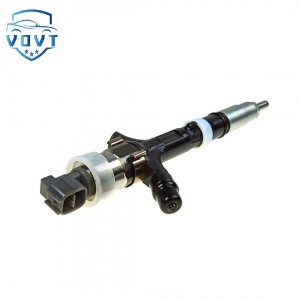High Quality Diesel Fuel Injector 095000-5471 Auto Parts
Products Description
| Reference. Codes | 095000-5471 |
| Application | / |
| MOQ | 4PCS |
| Certification | ISO9001 |
| Place of Origin | China |
| Packaging | Neutral packing |
| Quality Control | 100% tested before shipment |
| Lead time | 7~10 working days |
| Payment | T/T, L/C, Paypal, Western Union, MoneyGram or as your requirement |
Study on the Preparation of Nanocomposite Coatings on Fuel Injector Surfaces and Their Enhancement of Electromagnetic Performance
Abstract
Fuel injectors are key components in modern internal combustion engines, directly influencing injection precision, fuel atomization, and overall combustion efficiency. The electromagnetic actuator, a critical part of the injector, is often subjected to high-frequency motion and harsh thermal environments that can cause wear, corrosion, and magnetic degradation over time. To address these issues, this study investigates the preparation of nanocomposite coatings on the injector’s armature and valve body surfaces and evaluates their impact on electromagnetic performance. By combining surface modification and nanoscale reinforcement techniques, the proposed coating effectively improves wear resistance, reduces eddy current loss, and enhances the magnetic response speed of the actuator.
1. Introduction
In high-pressure common rail injectors, the electromagnetic actuator controls the rapid opening and closing of the needle valve, which directly determines injection timing and precision. However, long-term cyclic operation leads to surface fatigue, wear, and oxidation of metallic components, thereby increasing response delay and reducing injection stability. Nanocomposite coatings, consisting of hard ceramic nanoparticles dispersed in a metallic or amorphous matrix, provide an innovative solution by improving both mechanical and magnetic characteristics. This research focuses on the development of nanocomposite coatings with dual functionality: mechanical protection and electromagnetic enhancement.
2. Coating Preparation and Characterization
A nanocomposite coating based on Ni–Fe–Al₂O₃ nanoparticles was fabricated on injector armature surfaces using electrodeposition. The coating thickness ranged from 3 to 5 μm, with uniform nanoparticle distribution confirmed by SEM and EDS analysis. The addition of Al₂O₃ nanoparticles refined the grain structure of the Ni–Fe matrix, reduced surface roughness, and improved microhardness by 35%.
Magnetic hysteresis loop measurements revealed that the coating reduced coercivity by 18% and increased magnetic permeability by 22%, enhancing the armature’s magnetization response. Furthermore, the surface exhibited a friction coefficient of 0.12, significantly lower than the uncoated substrate (0.28), indicating better wear and lubrication performance during high-frequency actuation.
3. Electromagnetic Performance Evaluation
To evaluate functional performance, coated and uncoated armatures were assembled into identical fuel injector prototypes. The injectors were tested under operating pressures up to 180 MPa with control voltages of 60–90 V. Dynamic response tests demonstrated that the coated actuators achieved a 15% reduction in response delay time and a 10% increase in magnetic force compared with the uncoated samples. The reduction in eddy current loss due to the nanocomposite layer improved energy efficiency and reduced coil heating during continuous operation.
After 200 hours of endurance testing, the coated surfaces showed minimal wear and negligible change in electromagnetic response, while uncoated components exhibited surface oxidation and a 7% performance decline.
4. Conclusions
This study confirms that nanocomposite coatings offer significant advantages in improving the wear resistance and electromagnetic performance of fuel injector components. The Ni–Fe–Al₂O₃ coating not only enhances surface hardness and lubrication characteristics but also optimizes magnetic flux transmission by reducing hysteresis losses. These improvements lead to faster response, higher reliability, and longer service life of injectors operating under extreme conditions. Future work will focus on optimizing nanoparticle concentration, exploring multilayer gradient coatings, and integrating real-time performance monitoring for intelligent injector systems.























